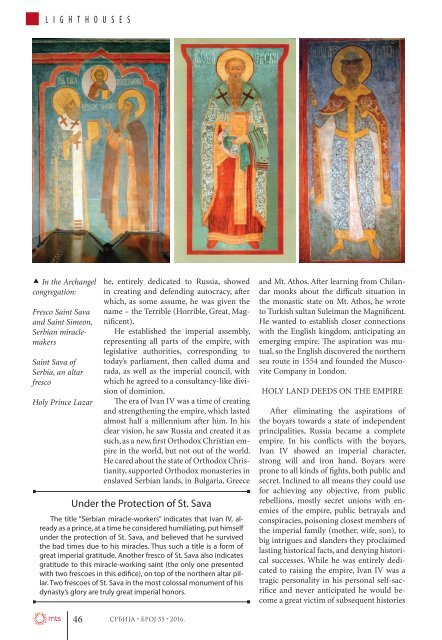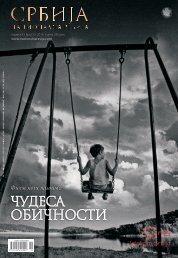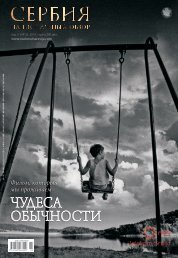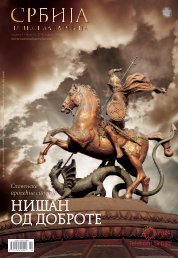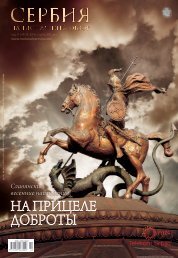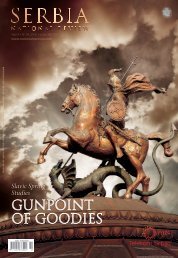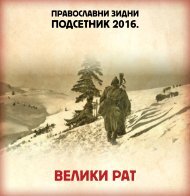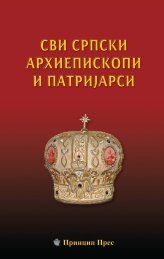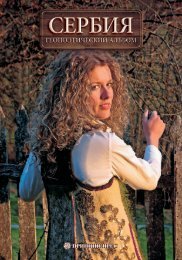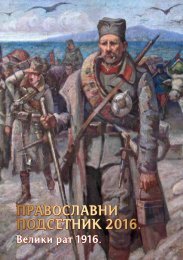Srbija - nacionalna revija - broj 55 - engleski - niska rezolucija
You also want an ePaper? Increase the reach of your titles
YUMPU automatically turns print PDFs into web optimized ePapers that Google loves.
L I G H T H O U S E S<br />
In the Archangel<br />
congregation:<br />
Fresco Saint Sava<br />
and Saint Simeon,<br />
Serbian miraclemakers<br />
Saint Sava of<br />
Serbia, an altar<br />
fresco<br />
Holy Prince Lazar<br />
he, entirely dedicated to Russia, showed<br />
in creating and defending autocracy, after<br />
which, as some assume, he was given the<br />
name – the Terrible (Horrible, Great, Magnificent).<br />
He established the imperial assembly,<br />
representing all parts of the empire, with<br />
legislative authorities, corresponding to<br />
today’s parliament, then called duma and<br />
rada, as well as the imperial council, with<br />
which he agreed to a consultancy-like division<br />
of dominion.<br />
The era of Ivan IV was a time of creating<br />
and strengthening the empire, which lasted<br />
almost half a millennium after him. In his<br />
clear vision, he saw Russia and created it as<br />
such, as a new, first Orthodox Christian empire<br />
in the world, but not out of the world.<br />
He cared about the state of Orthodox Christianity,<br />
supported Orthodox monasteries in<br />
enslaved Serbian lands, in Bulgaria, Greece<br />
Under the Protection of St. Sava<br />
The title “Serbian miracle-workers” indicates that Ivan IV, already<br />
as a prince, at a time he considered humiliating, put himself<br />
under the protection of St. Sava, and believed that he survived<br />
the bad times due to his miracles. Thus such a title is a form of<br />
great imperial gratitude. Another fresco of St. Sava also indicates<br />
gratitude to this miracle-working saint (the only one presented<br />
with two frescoes in this edifice), on top of the northern altar pillar.<br />
Two frescoes of St. Sava in the most colossal monument of his<br />
dynasty’s glory are truly great imperial honors.<br />
and Mt. Athos. After learning from Chilandar<br />
monks about the difficult situation in<br />
the monastic state on Mt. Athos, he wrote<br />
to Turkish sultan Suleiman the Magnificent.<br />
He wanted to establish closer connections<br />
with the English kingdom, anticipating an<br />
emerging empire. The aspiration was mutual,<br />
so the English discovered the northern<br />
sea route in 1<strong>55</strong>4 and founded the Muscovite<br />
Company in London.<br />
HOLY LAND DEEDS ON THE EMPIRE<br />
After eliminating the aspirations of<br />
the boyars towards a state of independent<br />
principalities, Russia became a complete<br />
empire. In his conflicts with the boyars,<br />
Ivan IV showed an imperial character,<br />
strong will and iron hand. Boyars were<br />
prone to all kinds of fights, both public and<br />
secret. Inclined to all means they could use<br />
for achieving any objective, from public<br />
rebellions, mostly secret unions with enemies<br />
of the empire, public betrayals and<br />
conspiracies, poisoning closest members of<br />
the imperial family (mother, wife, son), to<br />
big intrigues and slanders they proclaimed<br />
lasting historical facts, and denying historical<br />
successes. While he was entirely dedicated<br />
to raising the empire, Ivan IV was a<br />
tragic personality in his personal self-sacrifice<br />
and never anticipated he would become<br />
a great victim of subsequent histories<br />
46 SRBIJA • BROJ <strong>55</strong> • 2016.


